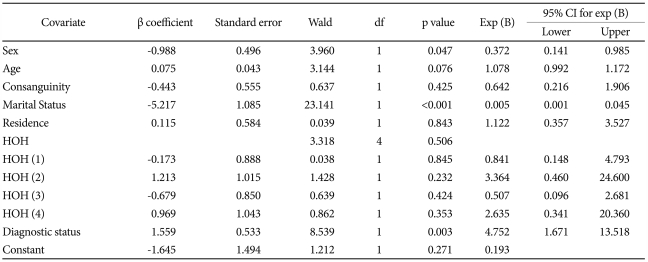1. Odegård O. Marriage and mental disease; a study in social psychopathology. J Ment Sci 1946;92:35-59. PMID:
20984292.


2. Odegård O. Marriage rate and fertility in psychotic patients before hospital admission and after discharge. Int J Soc Psychiatry 1960;6:25-33.

3. Laursen TM, Munk-Olsen T. Reproductive patterns in psychotic patients. Schizophr Res 2010;121:234-240. PMID:
20570491.


4. Stevens B. Marriage and Fertility of Women Suffering from Schizophrenia or Affective Disorders. 1969,London: Oxford University Press.
5. Ritsner M, Sherina O, Ginath Y. Genetic epidemiological study of schizophrenia: reproduction behaviour. Acta Psychiatr Scand 1992;85:423-429. PMID:
1642123.


6. Nimgaonkar VL. Reduced fertility in schizophrenia: here to stay? Acta Psychiatr Scand 1998;98:348-353. PMID:
9845171.


7. Odegård O. New data on marriage and mental disease: the incidence of psychoses in the widowed and the divorces. J Ment Sci 1953;99:778-785. PMID:
13109458.


8. Odegård O. Fertility of psychiatric first admissions in Norway 1936-1975. Acta Psychiatr Scand 1980;62:212-220. PMID:
7457168.


9. Haverkamp F, Propping P, Hilger T. Is there an increase of reproductive rates in schizophrenics? I. Critical review of the literature. Arch Psychiatr Nervenkr 1982;232:439-450. PMID:
7171300.


10. Saugstad LF. Social class, marriage, and fertility in schizophrenia. Schizophr Bull 1989;15:9-43. PMID:
2655069.



11. Fañanás L, Bertranpetit J. Reproductive rates in families of schizophrenic patients in a case-control study. Acta Psychiatr Scand 1995;91:202-204. PMID:
7625196.


12. Goldstein JM, Faraone SV, Chen WJ, Tolomiczencko GS, Tsuang MT. Sex differences in the familial transmission of schizophrenia. Br J Psychiatry 1990;156:819-826. PMID:
2207512.


13. Nanko S, Moridaira J. Reproductive rates in schizophrenic outpatients. Acta Psychiatr Scand 1993;87:400-404. PMID:
8356891.


14. Bassett AS, Bury A, Hodgkinson KA, Honer WG. Reproductive fitness in familial schizophrenia. Schizophr Res 1996;21:151-160. PMID:
8885043.



15. Baron M, Risch N, Mendlewicz J. Differential fertility in bipolar affective illness. J Affect Disord 1982;4:103-112. PMID:
6213688.


16. Jönsson SA. Marriage rate and fertility in cycloid psychosis: comparison with affective disorder, schizophrenia and the general population. Eur Arch Psychiatry Clin Neurosci 1991;241:119-125. PMID:
1834183.


17. Calzeroni A, Conte G, Pennati A, Vita A, Sacchetti E. Celibacy and fertility rates in patients with major affective disorders: the relevance of delusional symptoms and suicidal behaviour. Acta Psychiatr Scand 1990;82:309-310. PMID:
2260485.


18. Harlow BL, Wise LA, Otto MW, Soares CN, Cohen LS. Depression and its influence on reproductive endocrine and menstrual cycle markers associated with perimenopause: the Harvard Study of Moods and Cycles. Arch Gen Psychiatry 2003;60:29-36. PMID:
12511170.


19. Williams KE, Marsh WK, Rasgon NL. Mood disorders and fertility in women: a critical review of the literature and implications for future research. Hum Reprod Update 2007;13:607-616. PMID:
17895237.



20. Mansour H, Klei L, Wood J, Talkowski M, Chowdari K, Fathi W, et al. Consanguinity associated with increased risk for bipolar I disorder in Egypt. Am J Med Genet B Neuropsychiatr Genet 2009;150B:879-885. PMID:
19152378.



21. Petty RG. Prolactin and antipsychotic medications: mechanism of action. Schizophr Res 1999;35(Suppl):S67-S73. PMID:
10190227.


22. Howard LM, Kumar C, Leese M, Thornicroft G. The general fertility rate in women with psychotic disorders. Am J Psychiatry 2002;159:991-997. PMID:
12042188.


23. Vogel HP. Fertility and sibship size in a psychiatric patient population. A comparison with national census data. Acta Psychiatr Scand 1979;60:483-503. PMID:
539465.


24. Hutchinson G, Bhugra D, Mallett R, Burnett R, Corridan B, Leff J. Fertility and marital rates in first-onset schizophrenia. Soc Psychiatry Psychiatr Epidemiol 1999;34:617-621. PMID:
10703270.


25. Hendrick V, Gitlin M, Altshuler L, Korenman S. Antidepressant medications, mood and male fertility. Psychoneuroendocrinology 2000;25:37-51. PMID:
10633534.


26. Bhatia T, Franzos MA, Wood JA, Nimgaonkar VL, Deshpande SN. Gender and procreation among patients with schizophrenia. Schizophr Res 2004;68:387-394. PMID:
15099620.


27. Erlenmeyer-Kimling L, Nicol S, Rainer J, Deming W. Changes in fertility rates of schizophrenic patients in New York state. Am J Psychiatry 1969;125:916-927.

28. Wing JK, Sarotorius N, Ustun TB. Diagnosis and Clinical Measurement in Psychiatry: A Reference Manual for Scan. 1998,Cambridge: Cambridge University Press.
29. Mansour H, Fathi W, Lambertus K, Wood J, Chowdari KV, Watson A, et al. Consanguinity and increased risk for schizophrenia in Egypt. Presented at the XVII World Congress on Psychiatric Genetics 2009;San Diego, CA.

30. Nimgaonkar VL, Ward SE, Agarde H, Weston N, Ganguli R. Fertility in schizophrenia: results from a contemporary US cohort. Acta Psychiatr Scand 1997;95:364-369. PMID:
9197899.


31. Currier GW, Simpson GM. Antipsychotic medications and fertility. Psychiatr Serv 1998;49:175-176. PMID:
9575000.


32. Downey J, Yingling S, McKinney M, Husami N, Jewelewicz R, Maidman J. Mood disorders, psychiatric symptoms, and distress in women presenting for infertility evaluation. Fertil Steril 1989;52:425-432. PMID:
2776896.


33. Fassino S, Pierò A, Boggio S, Piccioni V, Garzaro L. Anxiety, depression and anger suppression in infertile couples: a controlled study. Hum Reprod 2002;17:2986-2994. PMID:
12407062.



34. Meller W, Burns LH, Crow S, Grambsch P. Major depression in unexplained infertility. J Psychosom Obstet Gynaecol 2002;23:27-30. PMID:
12061034.


35. Adriaens PR. Debunking evolutionary psychiatry's schizophrenia paradox. Med Hypotheses 2008;70:1215-1222. PMID:
18226861.



36. Bhatia T, Franzos MA, Wood JA, Nimgaonkar VL, Deshpande SN. Gender and procreation among patients with schizophrenia. Schizophr Res 2004;68:387-394. PMID:
15099620.


37. Waddington JL, Youssef HA. Familial-genetic and reproductive epidemiology of schizophrenia in rural Ireland: age at onset, familial morbid risk and parental fertility. Acta Psychiatr Scand 1996;93:62-68. PMID:
8919331.













